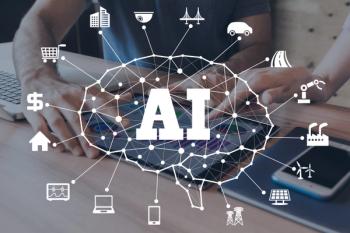
- Drug Topics February 2019
- Volume 163
- Issue 2
Six Healthcare Technologies Coming in the Next Five Years
Healthcare execs need to lay the cultural foundation today for upcoming technology changes
Experts agree that forecasting the future of healthcare technology isn’t difficult: machine learning, artificial intelligence (AI), and cloud technologies that apply to clinical, workplace, and financial processes will have better and richer incorporation into the industry.
But to get there, healthcare executives need to be laying the cultural foundation today for the technology changes coming in the next decade.
For example, investing in AI over the next five years could cost, on average, more than $30 million per organization, according to a survey of 500 healthcare executives by OptimIQ that was published in November 2018. However, 38% of employers and 20% of health plans believe they would see a return on that investment in four years or less. Ultimately, 94% of respondents see investments in technologies, such as AI, as the clearest route to affordable, accessible and equitable healthcare in the future.
But in order to realize those future possibilities, a culture shift needs to happen in healthcare today, says Tom Lawry, director of worldwide health for Microsoft. The future of healthcare technology relies more on the culture and framework being created by clinical and business leaders today, he tells Drug Topics.
“What really is going to be needed in the future is not just the breakthroughs in technology, but breakthroughs in creative thinking and the ability of leaders to think differently when redeveloping their processes to leverage the power of the technologies rather than trying to insert these new technologies into a framework,” Lawry says.
Read More:
Anil Jain, MD, vice president and chief information officer for Watson Health at IBM, says that healthcare organizations will need to shake the stigma of being bureaucratic and slow to adapt so they can be agile enough to adopt future technologies.
“Healthcare organizations need to start to push the agenda that says innovation is important to healthcare. People outside of healthcare view the industry as very conservative, very slow to adapt,” Jain tells Drug Topics. But when you talk to people inside the industry, we all think we’re moving very, very quickly. The key is for these healthcare organizations to get involved in the national debate, at the advocacy level and advising others on what the industry needs, so that movement is made collectively.”
These experts have given their insights on where healthcare technology will be the most impactful in the next decade.
Better Cloud Integration
Although devices collecting digital data are important to healthcare, how that data is shared is the most essential part of the equation, Lawry says.
More than 90% of healthcare organizations are widely using the cloud to host applications, according to a 2017 Healthcare Information and Management Systems Society (HIMSS) survey on cloud use. However, the industry is still using the cloud for separate functions, such as clinical apps, data hosting, and backup, and not in a holistic fashion. The survey found that though there is a high level of cloud usage at healthcare organizations, the functionality is still limited.
Use of cloud integration has allowed for data from different healthcare silos to be shared, and as more organizations continue to connect those dots, and Lawry says that it will transform the industry.
“Everyone’s digitizing their data, whether that’s electronic medical records or X-rays. But digitizing data doesn’t do anything other than that. It changes data from one form to another instance,” Lawry says. “The transformation that’s brought about by the cloud and bringing that data together allows for all kinds of interesting things. That to us is the number one transformational aspect going forward for the next few years.”
Deeper AI Infusion
Artificial intelligence has been a part of the healthcare for years, but experts believe in the next decade it will be a regular part of the industry.
A survey of 200 healthcare professionals by Intel Corporation, released in July 2018, found that 37% of respondents were using AI in limited ways, and 54% believe that there will be widespread AI adoption in the next five years.
John Doyle, director of business strategy for Worldwide Health Industry at Microsoft, says, moving forward, we should expect to see AI infused into all aspects of clinical and operational workflow.
Trending:
“We are early in the journey for cloud and AI adoption today, but we are already starting see some amazing progress being made, and we expect this continue and with a broader adoption of applied AI in areas such as the clinical interpretation of complex datasets, intelligent medical images, voice integration, and real-time insight of streaming medical devices and sensors data,” Doyle says.
As a new generation of consumer-focused services aim to merge patients and consumer journeys, applied AI will disrupt how patients engage with healthcare providers today, Doyle says. “Applied AI has the potential to reduce the complexity of how healthcare data is captured and analyzed, examples of this include how intelligent voice integration and bot technologies are being used during virtual consultations to reduce the time spent entering data by both patients and clinicians, and how pretrained clinical knowledge can be applied at the point of care.”
Continue reading on page 2...
Infrastructure Upgrades
The ability for clinicians to meet with patients via web and mobile portals is essential for chronic care management, says Rhonda Collins, DNP, RN, chief nursing officer at Vocera, and founder of the American Nurse Project.
“A majority of this country is still rural. So, we need to rely on technology to fill gaps in human connections in healthcare-telehealth will be more important going forward, as infrastructure and technology continue to improve. Hospitals and clinics will need to prepare for a world that technology is making smaller,” Collins says.
A 2017 report issued by the Federal Communications Commission found that 50% of U.S. counties house people who both have high occurrences of chronic diseases and a greater need for broadband connectivity. The commission called this “double burden,” and incidents can be as high as 60% in rural counties.
Realted Read:
“That makes a remote consultation with a doctor or video chat very difficult, but the situation is improving, and over time, I think at-home remote care will be most valuable in rural areas, where technology use is far more practical than a long drive to see a doctor,” Collins says.
As telehealth expansion continues through Medicare reimbursements, patients are still unclear about its availability and use. A survey released by Healthline in August 2018 found that 46% of Medicare Advantage members were unsure if telehealth was an option, and 37% stated telehealth was not offered even though it is.
Collins adds that hospitals are still lacking full-scale wi-fi and consistent cellular service, which impedes integration of telehealth and other mobile health offerings.
“These basic issues make it very difficult to bring technology in to provide extraordinary care and connectivity to all patients everywhere. Infrastructure upgrades are a must, and that should be the focus of many hospitals, so they can leverage great technologies that improve the lives of patients and clinicians alike,” Collins says.
Smarter Therapies
Though smart phones, smart watches and other smart devices are being used by consumers, a focus on “smart” hasn’t translated to healthcare solutions, says Kai Patel, MD, MBA, senior vice president of digital health at Flex, a solutions provider that builds intelligent products.
“By and large, many healthcare solutions lack meaning. They are not smart,” Patel says. “The data from them is either not collected at all or it is collected, and it stays in some type of local environment which inherently limits the value you can derive from that.”
Patel says in the next decade drug delivery devices such as insulin pens, biologic auto injectors, inhalers, and smart packaging for pills will become commonplace and enhance both clinical and business operations in healthcare. The goal of tracking this data is to add to the landscape of behavioral insights that can help enhance patient care. Patel says the ability to observe how patients use chronic therapies both inside clinical settings and at home or inpatient care settings is enhanced by integrated cloud and artificial intelligence use.
“Most of that technology is already there, so in the next five to 10 years it’s about unlocking that data. Once you can unlock that data, we will really be able to see progress using artificial intelligence and machine learning within those data sets,” Patel says.
News and Noteworthy:
Jain says IBM Watson is currently studying concepts around prescribing digital therapies that can be powered by blockchain and artificial intelligence and can be tailored to patients’ behavior.
“Wouldn’t it be really interesting if I prescribed an antidiabetes tablet, and I’m also prescribing an app on the patient’s smart phone that makes sure that they stay somewhat adhering to the medication? If they have any side effects, they’re educated about when they should see the doctor or when they could just simply ignore them,” Jain says.
Smarter therapies could also prescribe diets that work in conjunction with medications and give patients more feedback on their progress, he says. “The idea is that we have to go beyond the pill. As a physician, there has to be a better way to virtually have eyes on the patient even when they’re not in my exam room four times a year for 15 minutes.”
Enhanced Personal Medical Care
In the next decade, clinicians will have the ability to use blockchain, machine learning, and artificial intelligence seamlessly to provide specialized care to patients, says Jain.
“The biggest thing is going to be our ability to use these advanced technology enablers to get much better at doing personalized medicine and personalized healthcare with our patients,” Jain says. “Because the back-end healthcare technology is crunching all of their clinical data and administrative data, looking at their genomic profile, looking at their social determinates of health much faster than any human physician or clinician could, and combining that information in a trusted way.”
Jain says that fitness trackers are currently collecting siloed data, but are an important part of the equation when the data can be integrated along with other health determinants. Ultimately, he says more personalized treatments, especially for chronic conditions, would increase adherence to care plans.
“Essentially a clinician will have the ability to say, instead of just practicing in an evidence-based way, we’re going to combine evidence and personalized choices to give patients a much higher likelihood of being successful at the first set of treatments that are offered, instead of going back and forth a few times trying to figure things out,” Jain says.
Mimicking Consumer Tech
Collins says she is hopeful that the workflow technology the healthcare field adopts over the next ten years will match and adapt to technology that people are used to in other areas of their lives.
“Before a hospital shift, someone can sit in their cars and buy movie tickets, make dinner reservations, and chat with friends-all from their smart phones. They then enter the hospital for a day’s work, and many times, the technology landscape is entirely different,” Collins says. She fears that antiquated processes and devices in healthcare workplaces will be a deterrent to tech-savvy millennials.
Trending:
“When millennials go to work at a hospital, we are asking doctors, nurses and care teams to step back 20 years and use landline phones, fax machines, pagers, and overhead calls-all of which downgrade and add complexity to our millennial workforce. They carry a heavy burden every day working with patients in stressful hospital environments, and the very basic technology they’re using only adds to the stress,” Collins says. “Furthermore, we are adding to cognitive loads by forcing them to remember procedures and how to use outdated technologies they are not naturally accustomed to using. So, over time, antiquated technology that doesn’t mirror what is used in our personal life and is not secure will be eliminated. As younger people continue to enter the workforce, many hospitals will be forced to modernize.”
Articles in this issue
almost 7 years ago
Nine Ways to Help Patients Better Adhere to Their Medicationsalmost 7 years ago
Opinion: Hard Work is Inevitable, but Burnout is Notalmost 7 years ago
Opinion: Pharmacists Are Best Suited to Improve Adherencealmost 7 years ago
PPSI Honors Distinguished Person of the Yearalmost 7 years ago
Influenza Update: Antivirals Advance in Options, Indicationsalmost 7 years ago
Avoiding Pharmacist Burnoutalmost 7 years ago
How to Prevent Medication Errorsalmost 7 years ago
New Drug Review: Dsuvia (Sufentanil) for Acute Refractory Painalmost 7 years ago
Tax Cuts and Jobs Act of 2017 Affecting Pharmacy AccountingNewsletter
Pharmacy practice is always changing. Stay ahead of the curve with the Drug Topics newsletter and get the latest drug information, industry trends, and patient care tips.















































































































